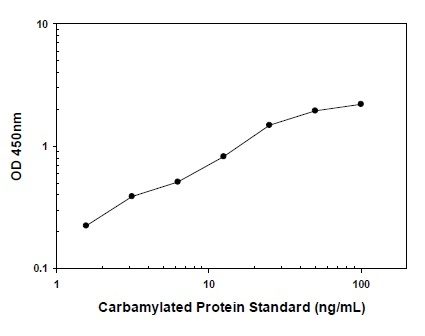anti-CD59 antibody [BRA-10G]
CAT.NO. : ARG56101
US$ Please choose
US$ Please choose
Size:
Trail, Bulk size or Custom requests Please contact us
*产品价格可能会有所调整,请以品牌方官网实时更新的价格为准,以确保准确性。
概述
| 产品描述 | Mouse Monoclonal antibody [BRA-10G] recognizes CD59 |
|---|---|
| 反应物种 | Hu |
| 应用 | FACS, FuncSt, ICC/IF |
| 宿主 | Mouse |
| 克隆 | Monoclonal |
| 克隆号 | BRA-10G |
| 同位型 | IgG1, kappa |
| 靶点名称 | CD59 |
| 抗原物种 | Human |
| 抗原 | Human K562 tumor cells. |
| 偶联标记 | Un-conjugated |
| 別名 | EJ30; MIRL; Membrane attack complex inhibition factor; CD antigen CD59; EJ16; Membrane inhibitor of reactive lysis; MIC11; EL32; HRF20; HRF-20; MEM43 antigen; MIN1; MIN2; MIN3; 1F5 antigen; 1F5; MACIF; MAC-IP; MSK21; Protectin; G344; p18-20; CD59 glycoprotein; MEM43; MAC-inhibitory protein; 16.3A5; 20 kDa homologous restriction factor |
应用说明
| 应用建议 |
| ||||||||
|---|---|---|---|---|---|---|---|---|---|
| 应用说明 | * The dilutions indicate recommended starting dilutions and the optimal dilutions or concentrations should be determined by the scientist. |
属性
| 形式 | Liquid |
|---|---|
| 纯化 | Purification with Protein G. |
| 缓冲液 | PBS (pH 7.4), 0.05% Sodium azide and 0.1 mg/ml BSA |
| 抗菌剂 | 0.05% Sodium azide |
| 稳定剂 | 0.1 mg/ml BSA |
| 浓度 | 0.2 mg/ml |
| 存放说明 | For continuous use, store undiluted antibody at 2-8°C for up to a week. For long-term storage, aliquot and store at -20°C or below. Storage in frost free freezers is not recommended. Avoid repeated freeze/thaw cycles. Suggest spin the vial prior to opening. The antibody solution should be gently mixed before use. |
| 注意事项 | For laboratory research only, not for drug, diagnostic or other use. |
生物信息
| 数据库连接 | |
|---|---|
| 基因名称 | CD59 |
| 全名 | CD59 molecule, complement regulatory protein |
| 背景介绍 | This gene encodes a cell surface glycoprotein that regulates complement-mediated cell lysis, and it is involved in lymphocyte signal transduction. This protein is a potent inhibitor of the complement membrane attack complex, whereby it binds complement C8 and/or C9 during the assembly of this complex, thereby inhibiting the incorporation of multiple copies of C9 into the complex, which is necessary for osmolytic pore formation. This protein also plays a role in signal transduction pathways in the activation of T cells. Mutations in this gene cause CD59 deficiency, a disease resulting in hemolytic anemia and thrombosis, and which causes cerebral infarction. Multiple alternatively spliced transcript variants, which encode the same protein, have been identified for this gene. [provided by RefSeq, Jul 2008] |
| 生物功能 | Potent inhibitor of the complement membrane attack complex (MAC) action. Acts by binding to the C8 and/or C9 complements of the assembling MAC, thereby preventing incorporation of the multiple copies of C9 required for complete formation of the osmolytic pore. This inhibitor appears to be species-specific. Involved in signal transduction for T-cell activation complexed to a protein tyrosine kinase. The soluble form from urine retains its specific complement binding activity, but exhibits greatly reduced ability to inhibit MAC assembly on cell membranes. [UniProt] |
| 细胞定位 | Cell surface |
| 预测分子量 | 14 kDa |
| 翻译后修饰 | N- and O-glycosylated. The N-glycosylation mainly consists of a family of biantennary complex-type structures with and without lactosamine extensions and outer arm fucose residues. Also significant amounts of triantennary complexes (22%). Variable sialylation also present in the Asn-43 oligosaccharide. The predominant O-glycans are mono-sialylated forms of the disaccharide, Gal-beta-1,3GalNAc, and their sites of attachment are probably on Thr-76 and Thr-77. The GPI-anchor of soluble urinary CD59 has no inositol-associated phospholipid, but is composed of seven different GPI-anchor variants of one or more monosaccharide units. Major variants contain sialic acid, mannose and glucosamine. Sialic acid linked to an N-acetylhexosamine-galactose arm is present in two variants. Glycated. Glycation is found in diabetic subjects, but only at minimal levels in nondiabetic subjects. Glycated CD59 lacks MAC-inhibitory function and confers to vascular complications of diabetes. |
 New Products
New Products




![anti-CD59 antibody [BRA-10G]](/upload/image/20241105/8415bc38bc270b898ee2a90369a6c7fb.jpg)












